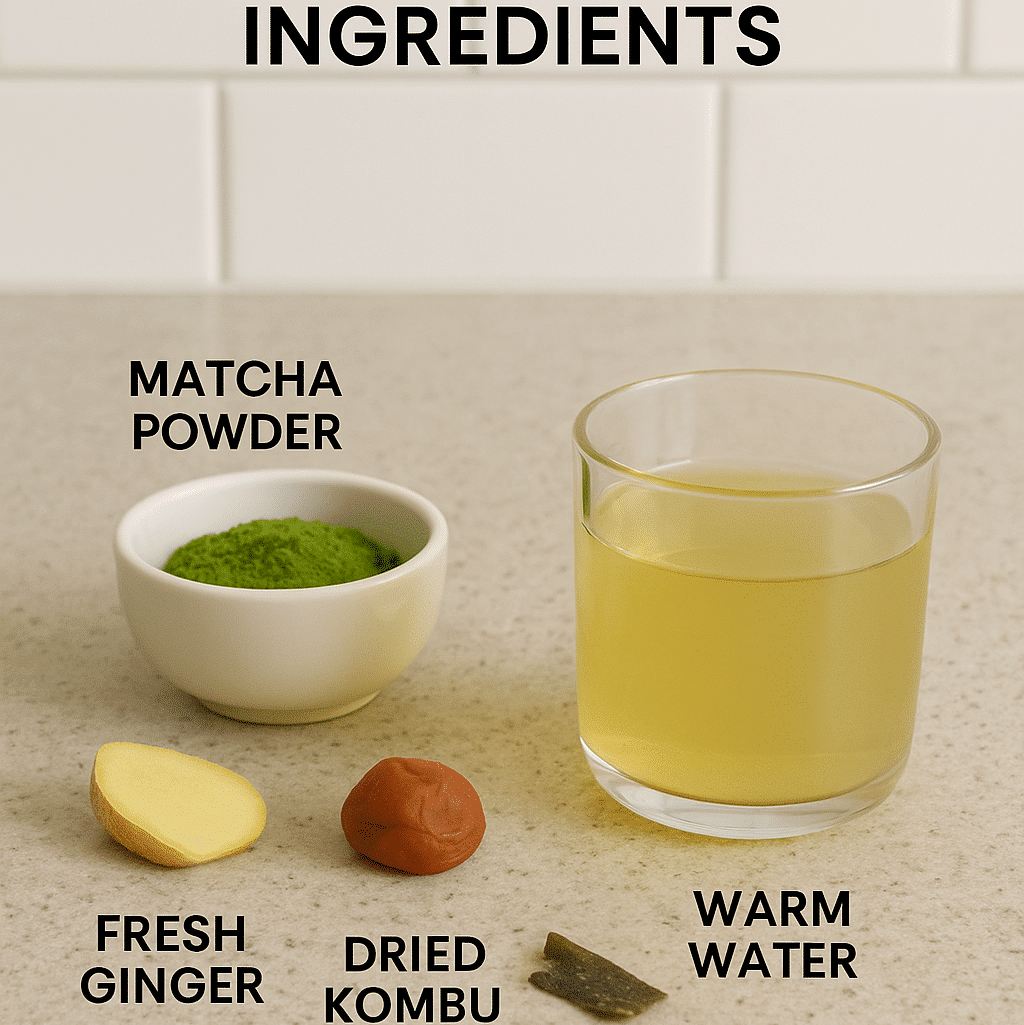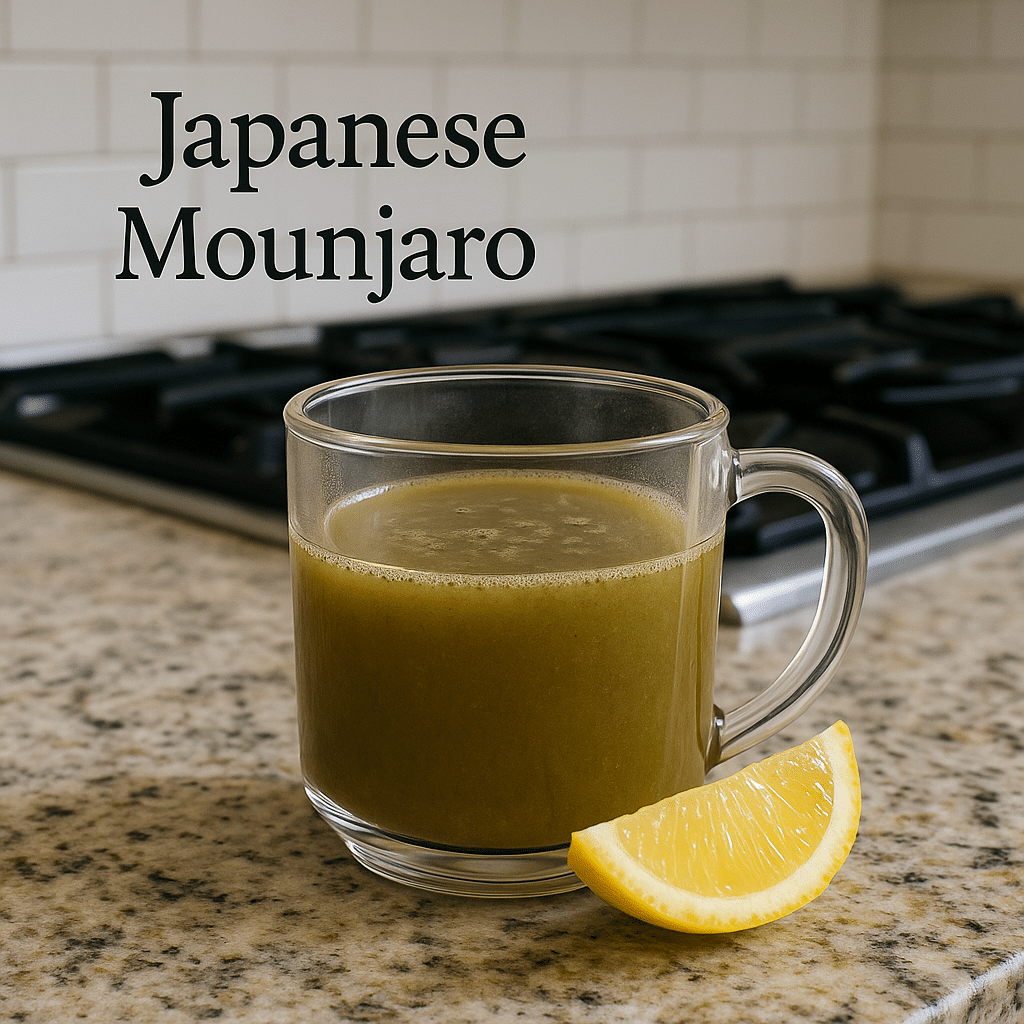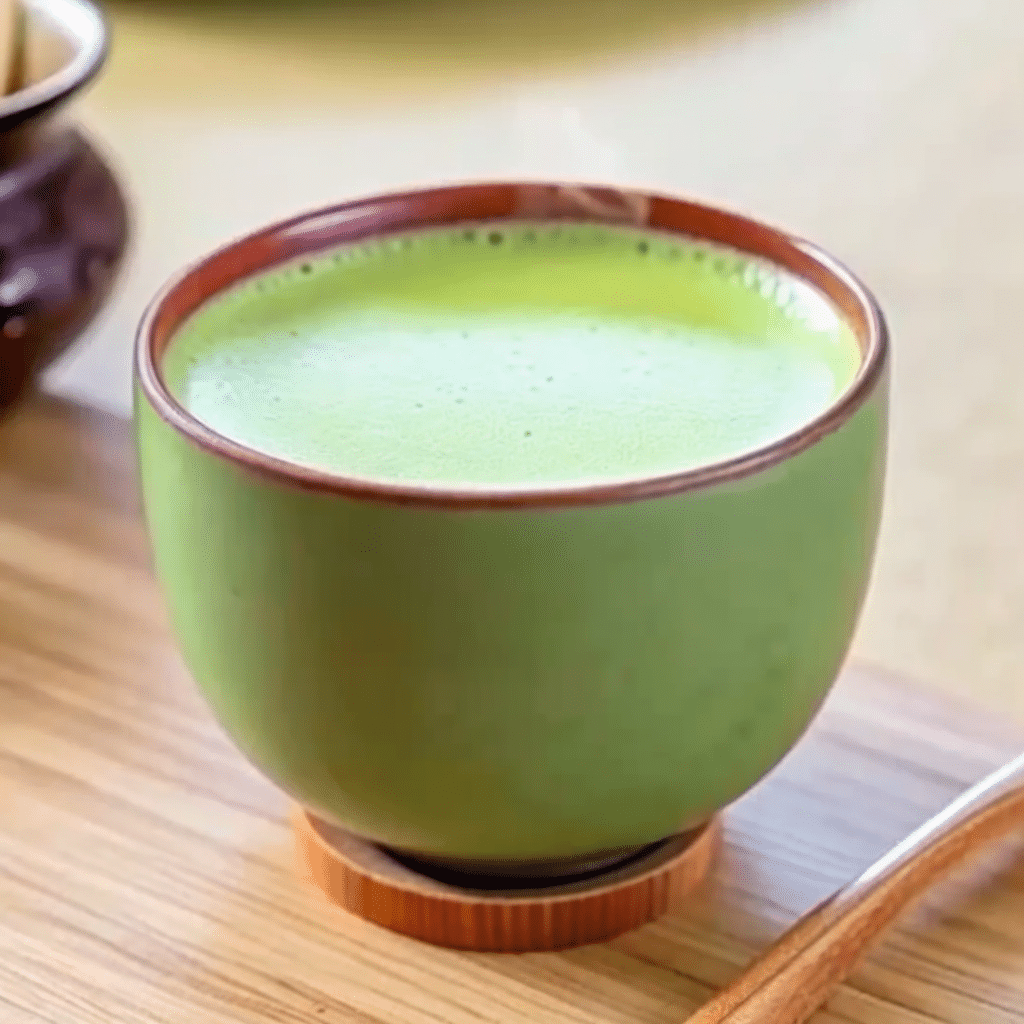It was during a trip to Kyoto that I first encountered the Japanese Mounjaro Recipe a traditional herbal drink whispered about in wellness circles for its ability to support weight loss, balance blood sugar, and boost energy, much like popular injections such as Mounjaro and Ozempic. But this wasn’t a pharmaceutical it was a cup of warm, earthy tea made from ancient Japanese ingredients.
What I found was more than a recipe it was a tradition rooted in Japanese wellness, using herbs that gently support blood sugar and appetite control. Since then, it’s become a staple in my kitchen and a favorite among my readers.
Today, I’m sharing everything you need to know to make it at home and feel the difference for yourself.
Table of Contents
Understanding Japanese Mounjaro Recipes and Their Rise to Popularity
What is Japanese Mounjaro recipe?
The Japanese Mounjaro Recipe isn’t a prescription, but it might just become your go-to daily ritual. Inspired by the effects of the pharmaceutical Mounjaro—known for its weight loss and blood sugar benefits—this natural version uses centuries-old Japanese herbs to gently support metabolism and appetite control.
While Mounjaro the drug relies on synthetic compounds to mimic GLP-1 hormone activity, the Japanese recipe blends ingredients like fermented root extracts, citrus peels, and herbal teas. The goal? A holistic effect that aligns with your body’s natural rhythm without synthetic interference.
Looking for inspiration? Try our guide on Brazilian Mounjaro Recipe with Apple Cider Vinegar a tangy twist on tradition.
The Origin and Cultural Significance in Japanese Wellness
Japan has always viewed food as medicine. The Kampo system of healing, rooted in ancient Chinese medicine but uniquely adapted to Japanese culture, emphasizes herbal remedies over pharmaceuticals. These formulas weren’t just used in sickness—they were daily tonics designed to build health and harmony from within.
The Japanese Mounjaro Recipe emerged from this tradition—taking influence from detoxifying teas, fermented foods, and metabolism-boosting herbs. It’s common to find versions of this tonic in rural Japanese households, passed down through generations as a trusted way to stay lean, energized, and balanced.
Japanese Mounjaro Recipe Step-by-Step
Crafting the Japanese Mounjaro Recipe is simple and soulful. It doesn’t require fancy supplements or synthetic additives—just pure, functional ingredients that support your body naturally. Here’s what you’ll need:
Low-caffeine version: If you’re caffeine-sensitive, reduce the matcha by half. You’ll still get a mild detox effect without the jitters.
No umeboshi? Try a pinch of sea salt and a squeeze of fresh lemon to recreate that savory-sour balance. It won’t replace the probiotics, but it gets you close in flavor.
Amp up the power: Boost the drink’s nutritional punch by adding a sprinkle of chia seeds for fiber or a splash of yuzu juice for a citrusy kick and extra antioxidants.
This drink combines the ancient energy of matcha with gut-soothing ginger, enzyme-rich kombu, and probiotic-packed umeboshi. It’s gentle, effective, and deeply rooted in Japanese health traditions.

How To Make Japanese Mounjaro Recipe
Enjoy this warm, healing tonic in the morning or as a midday wellness boost. It’s light, functional, and deeply satisfying—perfect for anyone seeking a natural alternative to Mounjaro without side effects.

Japanese Mounjaro Recipe: The Natural Alternative That Works
- Total Time: 10 minutes
- Yield: 1 serving 1x
Description
This Japanese Mounjaro Recipe is a natural, soothing tonic made with matcha, kombu, ginger, and umeboshi. Inspired by traditional Japanese wellness practices, it’s designed to gently support metabolism, balance blood sugar, and curb cravings—without synthetic ingredients. Easy to make in just 10 minutes, it’s the perfect daily ritual for natural weight management and gut health.
Ingredients
- 1 teaspoon matcha powder (good quality if possible)
- 1 umeboshi plum (or about 1 teaspoon umeboshi paste)
- 1 slice fresh ginger, finely grated
- 1 small piece dried kombu (thumb-sized)
- 8 ounces warm water (around 160–170°F)
- Optional: splash of lemon juice or drizzle of honey
Instructions
- Prep the ingredients Grate a thin slice of fresh ginger, measure out your matcha, and rinse your kombu piece to remove any surface salt.
- Heat the water properly Warm 8 oz of water to around 160–170°F—just below boiling. This protects the delicate nutrients, especially in matcha and kombu.
- Steep the kombu Add the kombu to the warm water and let it steep for 5 minutes. It will gently release minerals and its signature umami flavor.
- Whisk the matcha In a separate small bowl, add matcha powder with a splash of the warm water. Use a whisk or small frother to create a smooth, foamy blend.
- Mix the final brew Remove the kombu piece from the steeped water. Then stir in the grated ginger, umeboshi plum or paste, and the whisked matcha. Mix well.
- Adjust to taste (optional) Add a splash of lemon juice for brightness or a drizzle of honey for a touch of sweetness if desired. Both additions help balance the tart and earthy flavors.
Notes
For best results, use high-quality ceremonial matcha and avoid boiling water, which can destroy the nutrients in kombu and matcha. If umeboshi isn’t available, a pinch of sea salt and lemon juice can be used as a substitute. Drink daily before breakfast or midday for optimal digestive and metabolic support.
- Prep Time: 5 minutes
- Cook Time: 5 minutes
- Category: Drink
- Method: No-Cook
- Cuisine: Japanese
Nutrition
- Serving Size: 1 glass
- Calories: 25
- Sugar: 0g
- Sodium: 150mg
- Fat: 0g
- Carbohydrates: 5g
- Fiber: 1g
Health Benefits of Japanese Mounjaro Ingredients
Traditional Herbal Components Used in Japanese Versions
The magic behind the Japanese Mounjaro Recipe lies in its powerful natural ingredients—each selected not just for taste but for function. Rooted in traditional Kampo medicine, these herbs and botanicals have been used for centuries to support fat metabolism, regulate blood sugar, and enhance digestion.
Here are a few key components often used in authentic Japanese versions:
| Ingredient | Benefit |
|---|---|
| Yomogi (Mugwort) | Boosts digestion, supports detox, and helps regulate appetite. |
| Citrus Peel (Chenpi) | Improves metabolism and digestion, rich in antioxidants. |
| Fermented Barley Tea | Supports fat oxidation, rich in polyphenols. |
| Kudzu Root | Helps control blood sugar and reduce inflammation. |
| Green Tea (Matcha) | Increases thermogenesis and energy without harsh stimulants. |
These ingredients aren’t exotic fads—they’re staples in Japanese households and have stood the test of time for their mild, restorative effects on the body.
How They Support Weight Loss and Metabolic Health
What sets this recipe apart is how it mimics some of the benefits of GLP-1 receptor agonists—naturally. The herbs in the Japanese Mounjaro Recipe work together to:
- Regulate appetite naturally – Ingredients like kudzu and yomogi help you feel fuller longer without spiking insulin.
- Balance blood sugar levels – Citrus peels and fermented teas prevent sharp glucose spikes, aiding fat storage control.
- Support fat burning – Polyphenols in matcha and barley tea help boost metabolism during rest and light activity.
- Improve gut health – Fermented components encourage healthy digestion, which is key to sustained weight management.
Unlike synthetic drugs, these benefits develop gradually and are sustainable long-term with regular use.
Discover great ideas like the 3-Ingredient Mounjaro Recipe simple and powerful for beginners.
Comparing Japanese Mounjaro with the Pharmaceutical Mounjaro
What’s in the Pharmaceutical Mounjaro?
Mounjaro (tirzepatide) is a prescription medication developed to treat type 2 diabetes and aid weight loss. It works by mimicking GLP-1 and GIP hormones that help control blood sugar levels and reduce appetite. The injection is typically administered once a week and can lead to rapid weight reduction, especially when combined with a balanced diet and exercise.
Here’s a look at what pharmaceutical Mounjaro includes:
| Component | Function |
|---|---|
| Tirzepatide | Dual GLP-1/GIP receptor agonist that improves insulin response and reduces appetite |
| Inactive ingredients | Stabilizers and preservatives used in injectable form |
| Administered via | Injection (weekly dose, typically subcutaneous) |
While it’s effective, Mounjaro comes with potential side effects such as nausea, vomiting, fatigue, and gastrointestinal discomfort. Some users also report dependency on the drug to maintain results long-term.
Japanese Mounjaro vs Mounjaro Drug: Effectiveness, Cost, and Side Effects
The Japanese Mounjaro Recipe isn’t a pharmaceutical—it’s a food-based, natural alternative that supports similar goals in a more gentle, sustainable way. It doesn’t block hunger artificially or interfere with hormones. Instead, it helps the body naturally regulate appetite, metabolism, and energy through time-tested herbs and fermented components.
Here’s how they compare:
| Feature | Japanese Mounjaro Recipe | Pharmaceutical Mounjaro |
|---|---|---|
| Delivery method | Brewed drink (hot tonic) | Injectable (weekly) |
| Main goal | Natural weight support, blood sugar balance | Diabetes treatment, weight loss |
| Ingredients | Matcha, kombu, ginger, umeboshi, natural botanicals | Synthetic GLP-1/GIP agonist |
| Side effects | Rare (mild detox or stomach adjustment) | Common (nausea, vomiting, fatigue) |
| Cost | Low-cost (DIY ingredients) | High (requires prescription, insurance) |
| Long-term sustainability | Safe for daily use without dependency | Possible rebound after discontinuation |
While pharmaceutical Mounjaro may deliver faster results, it often comes at a price—both financially and physically. The Japanese alternative offers a slower but more sustainable path to wellness, ideal for those looking to avoid chemical intervention.
Tips for Enhancing the Effects of Japanese Mounjaro Recipe
Lifestyle and Dietary Practices That Improve Results
While the Japanese Mounjaro Recipe on its own offers incredible natural support for weight management and metabolic health, combining it with the right lifestyle habits can dramatically enhance its effectiveness.
Here are the top strategies to maximize results:
1. Time Your Intake Smartly
For the best results, drink the tonic:
- Before breakfast – jumpstarts digestion and metabolic processes
- Mid-afternoon – curbs cravings and prevents energy slumps
2. Pair With a Balanced Diet
Stick to meals rich in:
- Lean protein (e.g., tofu, salmon, eggs)
- Fiber-rich vegetables (broccoli, daikon, seaweed)
- Complex carbs (brown rice, sweet potatoes)
Avoid:
- Refined sugar
- Ultra-processed foods
- High-fat, fried snacks
This supports blood sugar balance and prevents insulin spikes, helping the recipe do its work.
3. Prioritize Gut Health
Since many ingredients in this recipe (like kombu and umeboshi) support gut flora, you’ll benefit more by:
- Including fermented foods (miso, natto, kimchi)
- Taking a daily probiotic
- Staying well-hydrated
4. Get Moving Daily
Light movement goes a long way. Try:
- 20–30 minutes of brisk walking after meals
- Simple yoga stretches to reduce stress and improve digestion
- Low-impact workouts like tai chi or swimming
These help regulate blood sugar naturally and enhance your body’s response to the tonic.
Check out the popular Brazilian Mounjaro Recipe to explore how different cultures approach weight control.
Best Times to Consume and What to Avoid
Knowing when to drink the Japanese Mounjaro Recipe is just as important as how you make it.
| Time of Day | Benefit |
|---|---|
| Morning (empty stomach) | Boosts metabolism, supports detox |
| Midday (before lunch) | Helps regulate appetite and energy |
| Evening (light dinner) | Aids digestion, prevents late-night snacking |
What to avoid:
- Drinking it with heavy or greasy meals
- Using boiling water (it damages active nutrients)
- Replacing it with sugary “detox teas” that offer little benefit
When used consistently, this natural weight-supporting drink becomes more than a health trend—it becomes a trusted part of your everyday wellness.

Common Mistakes to Avoid When Making Japanese Mounjaro
Using the Wrong Ingredients or Proportions
One of the easiest ways to reduce the effectiveness of the Japanese Mounjaro Recipe is by cutting corners with ingredients. Since this natural formula relies on traditional Japanese herbs and preparation methods, ingredient quality matters more than you might think.
Here’s what to avoid:
- Low-grade matcha – Poor quality matcha lacks the antioxidant punch needed to stimulate metabolism. Choose ceremonial or high culinary grade.
- Skipping umeboshi – This pickled plum supports gut balance and adds necessary acidity to the blend. If you skip it, you miss a key benefit.
- Improper ratios – Using too much kombu or ginger can overpower the drink and cause digestive upset. Stick to thumb-sized kombu and a single ginger slice.
Pro Tip:
Always use filtered water heated to 160–170°F. Boiling water can kill the active compounds in matcha, kombu, and umeboshi.
Cooking Techniques That Destroy Active Compounds
Traditional preparation is what makes this recipe work—and missteps during brewing can reduce its potency.
Common technique mistakes include:
- Overheating – Boiling kombu or matcha destroys delicate enzymes and antioxidants. Always use gently heated water.
- Skipping the whisk – Simply stirring matcha leaves it clumpy. Whisking it into a froth activates its texture and absorption.
- Too long steeping kombu – Kombu should steep for 5 minutes max. Longer steeping can result in bitterness and an off flavor.
| Mistake | Consequence |
|---|---|
| Using boiling water | Destroys matcha and kombu nutrients |
| Not frothing matcha properly | Reduces absorption and enjoyment |
| Substituting ingredients | May cancel metabolic and digestive benefits |
Avoiding these small but critical mistakes ensures your Japanese Mounjaro Recipe delivers on its promise—naturally supporting your metabolism, digestion, and energy without pharmaceutical interference.
Looking for inspiration? Try our Brazilian Mounjaro with Apple Cider Vinegar for an added detox boost.
Top Benefits of the Japanese Mounjaro Recipe
Weight Loss, Appetite Control, and Digestion
The Japanese Mounjaro Recipe may look simple, but its benefits run deep. Each ingredient is chosen for its proven role in supporting the body’s natural systems—especially for those seeking a non-pharmaceutical approach to weight and sugar control.
Here’s what you gain with consistent use:
1. Gentle Weight Support
This recipe isn’t a crash diet drink—it supports gradual, healthy weight loss by boosting fat metabolism and reducing cravings. Ingredients like matcha and ginger gently stimulate thermogenesis, helping you burn more calories even at rest.
2. Balanced Appetite
With the help of kombu and umeboshi, this tonic encourages a balanced appetite—not extreme hunger suppression, but a sustainable feeling of fullness. That means fewer energy crashes and better food decisions throughout the day.
3. Improved Digestion
Umeboshi’s probiotic benefits, combined with the digestive warmth of ginger, make this recipe a gut-friendly choice. Many users report reduced bloating and better regularity after just a week of use.
4. Blood Sugar Stability
Drinking the Japanese Mounjaro Recipe before meals may help buffer blood sugar spikes, thanks to ingredients like kombu and citrus acid from umeboshi. This is key for both weight management and preventing energy slumps.
5. Sustainable Energy
No jitters here. Unlike caffeine-heavy options, this matcha-based tonic offers smooth, sustained energy, making it a perfect midday alternative to coffee or soda.
| Benefit Area | Result You’ll Feel |
|---|---|
| Weight management | Natural, sustainable fat reduction |
| Appetite control | Reduced cravings, improved portion control |
| Digestive support | Less bloating, improved gut health |
| Energy & focus | Gentle boost without crash |
| Blood sugar regulation | Fewer highs and lows throughout the day |
FAQ About Japanese Mounjaro Recipe
How do you make Japanese Mounjaro?
To make the Japanese Mounjaro Recipe, steep kombu in warm water (160–170°F) for 5 minutes. Separately whisk matcha with a splash of warm water. Remove the kombu and stir in grated ginger, umeboshi plum or paste, and the frothy matcha. Optionally, add lemon juice or honey to taste. This soothing tonic supports digestion, energy, and natural appetite control.
What is a natural alternative to Mounjaro?
The Japanese Mounjaro Recipe is one of the best natural alternatives to the pharmaceutical drug Mounjaro. It uses time-tested ingredients like matcha, kombu, and umeboshi to support metabolism, balance blood sugar, and control cravings—without synthetic chemicals or side effects.
How does Japanese Mounjaro compare to Ozempic?
While Ozempic is a synthetic GLP-1 agonist prescribed for diabetes and weight loss, the Japanese Mounjaro Recipe offers a holistic alternative using food-based ingredients. It supports similar benefits—such as appetite control and blood sugar stability—without injections, side effects, or cost barriers.
What ingredients are in Mounjaro?
Pharmaceutical Mounjaro contains the active compound tirzepatide, a synthetic dual GLP-1/GIP receptor agonist, along with inactive stabilizers. In contrast, the Japanese version is made from whole ingredients like matcha, kombu, ginger, and umeboshi—natural compounds used in traditional wellness practices to support similar goals.
Conclusion
If you’re seeking a natural, sustainable path to better health, the Japanese Mounjaro Recipe is a powerful starting point. Grounded in centuries of Japanese tradition and backed by modern nutritional science, this simple drink supports the body’s metabolism, digestion, and energy levels—without synthetic intervention.
Whether you’re trying to reduce sugar cravings, lose weight gently, or simply boost your morning routine, this recipe offers a low-cost, low-risk solution worth trying.
Discover great ideas like these on our Make Top Ideas your go-to for natural recipes and remedies.

